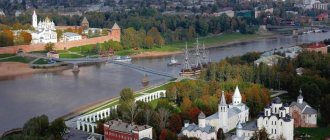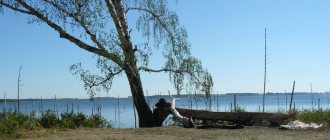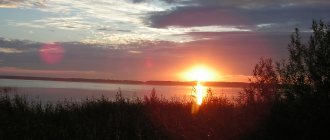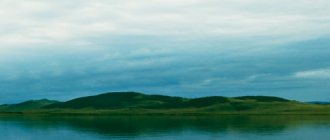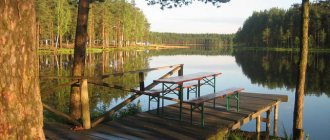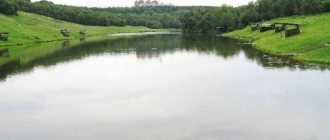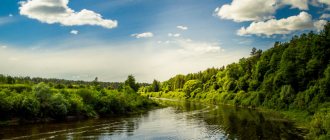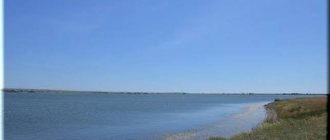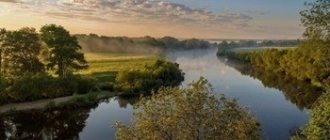White Lake
White Lake is a self-purifying reservoir located in the Nikolaevsky district of the Ulyanovsk region, in the center of the Volga Upland, on a watershed plateau whose height is 320 meters. This is a monument to the Ice Age, as the age of the lake is 250 thousand years.
The clear water of White Lake lives up to its name, as does the clean white sand. It has an oval shape, mineralization is insignificant. At the bottom there is silt consisting of dead algae, rotifer shells, pollen of coniferous plants, a small amount of sand and plant debris.
The banks are flat, low, and swampy in some places. Lake Beloye is stagnant and fed by water and produced by groundwater and atmospheric waters. In winter, the ice is 0.5-0.6 meters thick.
The lake contains representatives of Ice Age flora. Maples, perennial pines, lindens, mosses, lichens and dwarf birch grow on the banks.
The banks are covered with mixed forest with a predominance of ancient oaks and conifers. They create a favorable climate and improve the natural environment.
The lake contains the Limbay swamp with an area of 0.075 square kilometers. It has a peat deposit with a thickness of 2 meters, composed of sedge-sphagnum and sphagnum peats. The age of the alloy is approximately 6,000 years.
In 2009-2010, the lake became shallow; in 2010, a fire occurred here, which burned the Limbay swamp and almost the entire coastline.
Coordinates: 53.03349700,46.99997700
Black Lake
Black Lake is located in the high floodplain of the left bank of the Sviyaga River in the city of Ulyanovsk in the Zasviyazhsky district. This is an oxbow lake with an area of 6.8 hectares.
The open water surface is 1.8 hectares, the maximum depth is 2.42 hectares. The supply is of a surface-underground mixed type, it is connected with the Sviyaga River and its flowing channels. In summer, the water level is 1 meter above the edge of Sviyaga. Every year the water mass is completely replaced almost 25 times.
The water is slightly alkaline, hard, hydrocarbonate-sulfate-calcium-sodium.
In 1993, an ecological park was opened on the territory of Black Lake with 420 species of vascular plants, 20 species of fish, 7 species of amphibians, 1 species of reptiles, 11 species of mammals, 120 species of birds and 1500 species of invertebrates.
Coordinates: 54.29949700,48.34880900
Elkhovoe Ozero village (Tsilninsky district)
Sakhalin Moderator
Messages: 15308 Registered: 07 Aug 2013, 18:09 Name: Evgeniy Valentinovich Last name: Sofronov Place of residence: Ulyanovsk Phone: 917-624-72-87 Thanked: 430 times Thanked: 756 times Contact information:
Elkhovoe Ozero village (Tsilninsky district)
Post by Sakhalinsky » July 21, 2015, 11:47 pm
Elkhovoe Ozero village (Tsilninsky district)
Distance from Ulyanovsk to the reservoir near the village. Elkhova Lake (Tsilninsky district) about 55-60 km. Directions can be found HERE.
Fishing on the lake is FREE. By fish: Carp, crucian carp, perch, topwater
A little about the village of Elkhovoe Lake. [hide] '; > else [show] '; >;»> [show]
The village of Elkhovoe Lake is located 24 km northeast of the regional center of the town. Tsilna, in the valley of the Sviyaga River. Named after the lake overgrown with alder. Founded by the Tatars in 1649. In 1649, several families of Yasash Tatars from different villages of the Sviyazhsky district were transferred “to the sovereign’s equestrian service in the city of Simbirsk in the settlement of Elkhovka for eternal life.” In 1664, they “allowed” the village of four households of serving Tatars to join them, and then the Chuvash joined, and from that time the difficult path of struggle of the Elhovoozernsky Chuvash, as well as the Tatars, of course, for their existence began. Why is the village called Elkhovoe Lake, popularly Elshanka, and the Tatars and Chuvashs call it completely differently - Keshe? According to the receipt and expenditure book of 1667 / p. 50/ it is written: “... in the village of Olkhovaya, Ozernaya there were also 12 entire households, 3 households without a couple and 9 half-yards, and yasak was collected according to the salary from 19 households with a half-yard.” As you can see, there were two villages: Olkhovaya and Ozernaya. This is also confirmed by some legends that have survived to this day. For example, to the south of the village, behind the garden and the Bugurninskaya river there is a place called “Baka Yafragy”. There is a slight hill here. When the ground is excavated, coins and household items dating back to 1660-70 are recovered. Therefore, we can assume that the first “migrants”, service Tatars, lived here for some time and this settlement was called “Ozernaya”, since there are lakes all around. Read more HERE.
The village is located in a lowland, so groundwater is shallow from the surface. In the wells, the water is at a depth of up to 6 m. In the spring, melt water flows through rural streets, so for ease of movement, drains from pipes are built on the alleys.
Source
Chekalinskoye Lake
Lake Chekalinskoye is located in the southwestern part of the Kuzovatovsky district in the Ulyanovsk region, 4 kilometers from the village of Lesnoye Chekalino. It is located at an altitude of 273 meters above sea level, its length is 0.54 kilometers, width - 0.54 kilometers, area - 40 hectares.
The lake depression formed among sandy rocks at the watershed of the Temryazanka and Tomyshevka rivers. The lake has gentle slopes. Swamping occurs through overgrowing from the bottom and the growth of sphagnum raft. Of great scientific interest is the raft with northern plant communities, an area of 7 hectares and a peat thickness of 80 centimeters. Rare medicinal and valuable food plants grow on the raft, including swamp gammarbia, sundews, three-leafed butterfly, swamp cranberry, swamp scheuchzeria and white beetroot.
Cranberries bear fruit well. On the surface of the water there are a large number of islands of vegetation, consisting of reeds, cattails, sedges and cinquefoil.
Chekalinskoye is a natural monument; it is one of the protected wetland sites.
Coordinates: 53.47505900,47.54221700
Sights of Ulyanovsk
Square N.M. Karamzina, Ulyanovsk, Russia Museum complex, Ulyanovsk, Russia Museum of Photography of Simbirsk, Ulyanovsk, Russia Museum of the Simbirsk Merchants, Ulyanovsk, Russia Historical and Literary Museum of I.A. Goncharov, Ulyanovsk, Russia Museum-Memorial of V.I. Lenin, Ulyanovsk, Russia
Lakes of Russia
Lake Rayyavr, Murmansk, Russia Lake Bolon, Khabarovsk, Russia Lake Dvinye, Pskov, Russia Soldatskoye Lake, Ufa, Russia Yasskoye Lake, Pskov, Russia Lake Tolvand, Murmansk, Russia
Lakes of the world
Chott El Jerid Lake, Tunisia, Tunisia Jinji Lake, Suzhou (Jiangsu, Gansu), China Lake Wakatipu, Queenstown, New Zealand Inle Lake, Inle Lake, Myanmar (Burma) Khuvsgol Lake, Ulaanbaatar, Mongolia Talmen Lake, Ulan -Bator, Mongolia Lake Gatun, Soberania Park, Panama Lake Borovoe, Borovoe, Kazakhstan Lake “Greater Wannsee”, Berlin, Germany Lake Prespa, Thessaloniki, Greece Lake Tegernsee, Bavaria, Germany Lake Louise, Alberta, Canada
Relief, features of water resources of the region
The relief of the Ulyanovsk region began its history 25 million years ago, when its territory began to rise above sea level. Currently, the average height on the surface is about 180 m. The highest height is 353 m.
The region's water resources are significant; there are 2,033 rivers and streams, the total length of which is more than 10,000 km.
There are 1223 lakes, 230 ponds, and about 800 springs in the region. Almost the entire river flow, the volume of which is more than 240 cubic kilometers, goes to the Volga.
The largest river in the Ulyanovsk region is the Volga. Other relatively large rivers are the Sura, Big Cheremshan, Small Cheremshan, Maina, Sviyaga. They are tributaries of the main water artery of the European part of Russia - the Volga.
The majority of rivers in the Ulyanovsk region (more than 75%) are up to 5 km long. The diet is mixed, the following phases of water supply are characteristic: flood in the spring; low water in summer and winter; autumn and summer rain floods.
The flood of the rivers of the Ulyanovsk region continues for almost a month. The volume of runoff during this period is approximately 30 - 90% of the annual one. Low water levels in Ulyanovsk rivers (low water) occur from May to June. At this time, they are fed mainly by groundwater. Their abundance directly depends on various tectonic and hydrological factors and is uneven.
Ice appears on the rivers and lakes of the Ulyanovsk region at different times. In the southern regions it is recorded by the end of November. In the northern parts it is the beginning of November. Rivers open mainly in early April. Spring ice drift is short-lived, about 5 days.
There are also significant reserves of groundwater in the region. And also healing, mineral. Especially notable in this regard are the underground rivers of the Ulyanovsk region (Ulyanovsk region), from which mineral water is extracted to the surface, sold under the Volzhanka brand (Undory village).
Lakes of the Ulyanovsk region
In 2021, a multi-year project of the Ulyanovsk regional branch of the Russian Geographical Society “Lakes of the Ulyanovsk Region” was launched. This project is a logical continuation of the “Rivers of the Ulyanovsk Region” project completed in 2015 and is aimed at a comprehensive study of stagnant water bodies in the region.
The project was implemented jointly with Ulyanovsk State Pedagogical University named after. I.N. Ulyanov, Ulyanovsk State University, Ulyanovsk Regional Museum of Local Lore. I.A. Goncharov and Scientific Research.
During the 2021 field season, four expedition trips were carried out (May, June, August), during which 8 lakes in four districts of the Ulyanovsk region. In the first year, attention was paid mainly to lake natural monuments of regional significance ( Kryazh , Svetloye , Poganoe , Zotovo , Chekalinskoye and Beloe ). These reservoirs are relict for the region under study and are characterized by the presence of well-defined sedge-sphagnum raft. In addition, a survey was also carried out of the largest lake in the Ulyanovsk region - Belolebyazhye and Lake Stanovoe , which was subjected to peat mining in the last century.
In 2021, more than 26 people took part in field work, including doctors and candidates of biological sciences, graduate students and students of specialized biological specialties. Research was carried out in the main areas of floristry and faunistics, as well as landscape science, hydrology and anthropogenic impact on water bodies. Particular attention is paid to the condition of rare species of aquatic and semi-aquatic plants and animals listed in the Red Book of the Ulyanovsk region.
Free fishing in the Ulyanovsk region
Most residents of the Ulyanovsk region love fishing, and guests of the region also show great interest in it. Why such interest? The first is, of course, the beautiful nature, the second, the pleasure of fishing. It must be said that even in winter you can see a large number of fishermen on the reservoirs. Let's take a closer look at the topic of fishing in the Ulyanovsk region, and try to describe the most popular fishing spots.
Here are the TOP 10 best places where you can fish for free in the Ulyanovsk region:
Volga River (Panshino village)
Description, what kind of fish is found, how to get there:
According to experienced fishermen, it is this area that, for some unknown reason, attracts a lot of different fish. A small village located on a hillside, washed by the large expanse of water of the Volga. The bottom of the reservoir mainly consists of thick silt, sometimes there are stones or shells, and small islands can be seen formed along the entire surface of the reservoir. At the beginning of spring, anglers come to this place with the goal of catching as many roaches as possible; at this time there are a lot of them here. Also during this period, ide and chub are often caught. Armed with a couple of float rods and taking a boat with you, you can bring home quite a lot of fish. And if you have a quok at your disposal, then by the end of fishing there will definitely be a catfish in the cage.
Since September, bream has predominated in the reservoir. Many experienced anglers have discovered the best place for fishing, located not a few kilometers above the village. For local residents, this place is known as the Monastery, because there are remains of an old chapel in the area. It should be noted that a float rod is not entirely suitable for catching bream; in this case, it is recommended to use a donkey. If someone is not familiar with this tackle, then a donka is a feeder that, when cast, lies on the bottom. This tackle can be made more fully with your own hands.
GPS coordinates: 52.92087, 48.44868
2. River Uren
Description, what kind of fish is found, how to get there:
This river has a length of 42 kilometers and flows throughout almost the entire Ulyanovsk region. Uren belongs to the Volga basin. This is one of the favorite places for winter fishing enthusiasts. You need to know that if you go to a pond before dawn, you can catch active fish, most often it is perch; after the sun appears, roach most often bites.
Perch usually stay as close to the shore as possible. Approximately five meters away it is already necessary to make at least 4 holes, get acquainted with the local terrain. It's best to take some time to find where the schooling bass are and start fishing. It is recommended to use bloodworms as bait.
When fishing for roach, it is also necessary to make several holes, but the depth should already reach at least 10 meters, and preferably 15. It is necessary to take into account that bait for roach in the cold season may not mix well, therefore, it is best to do this in advance at home.
GPS coordinates: 54.29408, 49.10472
3. Biryuch River
Description, what kind of fish is found, how to get there:
This river is the left tributary of the Sviyaga. Its length is about 60 kilometers. This place attracts not only fishermen, but also just vacationers, since the water in the reservoir is incredibly clean and the nature is beautiful.
With just one float rod you can catch a lot of dace and bluefish, which usually live in pits. Recommended bait is worms, bread, dough. Often a chub is caught on a fishing rod; it is caught mainly on light and ultralight rods. It is best to cast gear downstream near vegetation or at a bend in the river. Here, chicken and goose liver, as well as May beetle larvae, have proven themselves to be the best bait.
But you need to know that the chub is listed in the Red Book of the Ulyanovsk region. That is, it is best to release the chub into its natural environment and keep a small part of the catch for yourself, otherwise there may be serious consequences.
The Biryuch River is also rich in burbot, which is best caught on a donkey. Mostly the bite occurs at night or at dawn. A small minnow or frog will work well as bait; finding such bait is not very difficult. The only drawback of the river is that the roads around the reservoir are unsuitable for driving. It is very difficult to get around there in four-wheel drive vehicles, but it is best to leave the car nearby and go on foot
GPS coordinates: 54.50742, 47.94539
Shale mine
Description, what kind of fish is found, how to get there:
This place is best visited by off-road vehicle, but it is recommended to have a boat at your disposal. There is only one road leading to the reservoir, passing through the forest, and therefore it is very difficult to get to the reservoir.
The bait can be a spinner, a spinner, or you can also fish with a jig rod. The reservoir is home to roach, catfish, pike perch, and bream.
Features of fishing in the reservoir:
- Cast towards the dump.
- Worms are the most popular bait in that area.
- It is better to use heavy bait.
- The main gear is a donk and a float rod.
The bottom of the bay consists entirely of silt, so this is the best place for swimming, as well as for relaxation in general.
GPS coordinates: 54.44722, 48.38416
5. Dubravka
Description, what kind of fish is found, how to get there:
The village of Dubravka and the adjacent reservoirs are famous for their large number of crucian carp. It bites both on most plant baits and on some animals. The tackle can be either float or spinning tackle.
It is also common for carp to be hooked, most often serious bites occur 10 meters from the shore. The best bait for this fish is canned corn and boilies. This place also has several disadvantages, the first is the constant noise coming from the highway, the second is the lack of a place to stay overnight, and the third is the small amount of vegetation.
GPS coordinates: 53.86568, 49.44553
Kuibyshev Reservoir (Yurman Bay)
Description, what kind of fish is found, how to get there:
The place is located on the left bank of the Kuibyshev reservoir, and its length is about 10 kilometers. The reservoir is not very deep, the maximum depth is no more than 4 meters. Bream, white bream, perch, roach and crucian carp are actively biting here.
In a pond, it is advisable to fish not from the shoreline, but from a boat. It is better to use a float rod as tackle. It is recommended to cast along the shore and closer to the reeds. The best bite is guaranteed in the early morning or late afternoon.
Yurmansky Bay has several recreation centers throughout its territory; this is a great place not only for fishing, but also for relaxation.
GPS coordinates: 54.44512, 48.75421
7. Ozerki
Description, what kind of fish is found, how to get there:
The place is notable for its large number of crucian carp and crucian carp, and you don’t need to have a boat for successful fishing. The main thing is that the chosen tackle is long enough.
Crucian carp responds well to semolina, worms and cereals in the morning. You need to keep in mind that in summer the place attracts a lot of mosquitoes, so you should definitely take the appropriate repellent with you.
GPS coordinates: 54.29732, 49.0599
FREE SEATS BY AREA
1. Ulyanovsk district. In the Undor area you can catch bream, perch and asp from a boat using a spinning rod. Asp and pike live near Palcin Island. Kriushinsky Bay is rich in bream, perch and asp.
2. Mainsky district. Fishermen in the region, by inertia, visit Lake Belolebyazhye, which used to be home to very large crucian carp. For carp you can go to Vyazovka, Sosnovka, Sushchevka and Zelenya. Abramovsky fontanelles have pretty much lost their former fishing glory. Novomalyklinsky district. There is little choice here. Novomalyklin residents mainly fish on Cheremshan in the area of Novocheremshansk and Staraya Besovka.
3. Staromainsky district. In the Staromainsky Bay in the Sadovka area, crucian carp are biting, small fish like bluefish, roach, and rudd are biting. In the Berezovsky Bay there are carp, in shallow water there are silver bream, crucian carp, bleak, carp, asp, and catfish are used for live bait. In the area of the Golovkin Islands there are crucian carp, carp, and pike.
4. Sursky district. Fishermen concentrate on the Barysh and Sura rivers. They catch bream, catfish, and various small river fish. Occasionally a sterlet is caught. The lakes in the Sura floodplain are famous for their crucian carp habitat: Surka, Dolgoye, Rubezhnoe, near the villages of Baryshskaya Sloboda, Polyanka, and Sara.
5. Melekessky district. In Cheremshansky Bay there are up to 60 species of fish that live in the Volga. In shallow waters, carp, carp, perch, silver bream, and bersh bite best. Dimitrovgrad residents fish in the suburbs, from the railway bridge to the water intake. Podbelka pond behind Brigadivka is managed by the regional society of hunters and fishermen, where carp, bream, carp, and crucian carp are released.
6. Cherdaklinsky district. In the area of the Turgenev Islands they take roach, silver bream, and crucian carp. In the Yurmansky Bay they catch silver bream, crucian carp, blue bream, white bream, ruffe, and gudgeon. In Ivanovo Bay - the same thing and more crayfish. Around Cherdakly the most fishy lakes are Peschanoe and Yaik. They are mainly inhabited by crucian carp. Loaches are caught in many small lakes. For crucian carp they also go to ponds in Urenbash, Ozerki, Tatarsky Kalmayur.
7. Veshkaimsky district. In recent years, Stemassky Pond was considered the most fishy place, where crucian carp, carp, perch, and bream are found. But fishermen complain that the entrepreneur who rented the pond charges a fee for fishing, or even prohibits fishing altogether. In Kargin, roach, crucian carp and carp are biting. In Krasny Bor and Krotovka there is also perch. The main enemy of Veshkaim fishermen is “electricians”. Where they go with electric fishing rods, the fish don’t take fish at all for two weeks. By the way, this is not a scourge of a single region, and everywhere it is being trumpeted loudly.
8. Karsun district. Komarovsky Pond is especially popular here, where you can find carp, perch, but mostly crucian carp. In the lakes of the Sur floodplain, rotan and other river fish are caught.
9. Kuzovatovsky district. Fishermen prefer Baevsky ponds. They bring pike and large carp from there. There are good ponds in Chirikovo, in the Chertanovka area, between the village and the regional settlement of Kuzovatovo - Igoninsky Pond. Nearby is Lake Zotovo.
10. Baryshsky district. On the Barysh River you can come across squirrels and minnows. The most fishy place in the area is Izmailovo. Here, in the Zeleny, Lyagushatnik, Verkhniy and Nizhny ponds, you can find mirror carp (sometimes more than 10 kg), roach, and perch. 7 km from Izmailovo, in the Stanovoe tract, there are a lot of different fish: rudd, silver carp, chub, tench.
11. Inzensky district. There are catfish and pike in the Sura River. Carp and crucian carp are caught in Repyevka. And on the famous Yulovoe Lake they bite pike, perch, roach, and crucian carp. Crucian carp are caught in small lakes and swamps along the Sura.
12. Nikolaevsky district. The main fishing spot is White Lake. Here are bream, white bream, silver carp, chub, and rudd. Fishermen go to the Baranovsky and Davydovsky ponds. They fish on the rivers Kanadeyka, Malyavka, Elshanka, Syzranka.
13. Starokulatkinsky district. Silver carp, crucian carp, bream, rudd - these fish can be caught at the dams in Srednyaya Tereshka and Ust-Kulatka. The Tereshka River, according to local residents, is generally fishy.
14. Terengulsky district. Two ponds in Terenga are home to crucian carp and crucian carps. There is trout in the Baramytka River, but fishing for it is prohibited. There are huge carp in Sosnovka. The reservoirs in Yasashnaya Tashla and Molvin are stocked with crucian carp, carp, and perch. In the river below the ponds there are chub. In the Usa River and in the oxbow there are kilogram pikes.
15. Bazarnosyzgan district. In the artificial reservoir near the village of Papuza, carp, silver carp, and perch are biting. But this fishing spot was chosen by poachers coming from the Inzensky and Baryshsky districts. In the lake on the outskirts of the regional village, crucian carp are caught.
16. Pavlovsky district. In the Kulebaksky, Ivanovsky, Starocherkovsky, Ilyushkinsky, Ozersky ponds, mainly cyprinids are caught, but silver carp, gudgeons, algae, and crucian carps are also found.
17. Novospassky district. There are few fishing spots here. One river is Syzranka, and even in that river there are only minnows.
18. Radishchevsky district. In the Saratov Reservoir, in the area of the villages of Panshino and Vyazovka, they catch catfish, pike, pike perch, bream and bream, and there is sabrefish, crucian carp, and carp. In the ponds on the Syzransky state farm and on the territory of the Orekhovskaya agricultural firm, crucian carp and carp are fished. In the rivers there are roaches, ruffes, and minnows.
19. Sengileevsky district. Sengilei, Shilovka - in the Volga, bream and bream are caught from great depths on a spinning rod, perch, sinew, and sometimes pike and pike perch are biting.
20. Tsilninsky district. Almost every village has a fish pond where carps, chubs, sinews, crucians, and carp are found.
Do you know any other good places for fishing in the Ulyanovsk region - write in the comments
